The International Advertising Bureau (IAB) implemented ads.txt in 2017 as a way to fight fraud by helping ad buyers avoid illegitimate sellers who arbitrage inventory and spoof domains. It’s important to publishers as well: ad buyers have declared that, by the end of 2019, they will no longer purchase inventory without an updated ads.txt file.
This FAQ will guide you through creating, updating, and maintaining your ads.text file. Below, you can jump to the starting point you’re looking for.
If you need quick implementation guide click here. And remember, if you don’t have your ads.txt, please reach out to support@sovrn.com to get your ads.txt file.
For further information on ads.txt, its importance, and its implementation, please visit the IAB guide to ads.txt. You can also visit our blog for valuable publisher news.
What is ads.txt?
Ads.txt is an initiative from the Interactive Advertising Bureau Tech Lab (IAB) to promote and improve transparency in programmatic advertising. It’s an easy way for publishers to clearly indicate to buyers who is authorized to sell their inventory.
How does ads.txt actually work?
The Ads.txt file is a public declaration by a publisher to say who the publisher authorizes to sell advertising on the publisher’s site. Once the Ads.txt file is posted, advertisers or DSPs acting on behalf of advertisers can scan sites and catalog the Ads.txt information for future use.
When an advertiser gets a bid request, they can check their catalog of Ads.txt information to verify that the bid request is coming from an authorized seller.
In addition, and if an advertiser wins a bid request, the advertiser will only pay the authorized seller, thereby further reducing the incentive for fraudulent actors to spoof domains.
Why can’t a spoofer just look at a site’s Ads.txt file and use that information?
The Ads.txt file references a publisher’s Account ID and not the fraudster’s, preventing the fraudster from getting paid for spoofing a site. This eliminates the incentive for fraudsters to spoof someone’s content.
On the Demand side, partners would see that the ID making the request differs from the ID in the ads.txt file and the request would be considered invalid.
Ads.txt File Creation
Follow the steps below to create your ads.txt file. For WordPress users, you can easily download Ads.txt Manager. If you’re not using WordPress, follow the instructions below.
1) Open or download a FTP service
- File Transfer Protocol (FTP) is an easy way for you to transfer files from your computer to your website.
- Sovrn recommends for WordPress users or FileZilla. It’s free, open source, and easy to use. As long as your ads.txt page has a file path resulting in https://domain/ads.txt, how you go about creating that file is completely up to you. Make sure to follow the format specifications carefully, but feel free to stick with the creation method of your choice. The following instructions outline one of many options available to you.
2) Create a .txt file with your ads.txt information.
- Create a new .txt file and label it ads.txt.
- To create a text or .txt file, all you need is a text editor or a word processing program such as Microsoft Word, WordPad, Notepad, or Atom.
- Save the file in the .txt or Plain Text file format option. Make sure it’s in an easy-to-locate folder on your computer. We’ll add the required ads.txt information in steps 3 and 4.
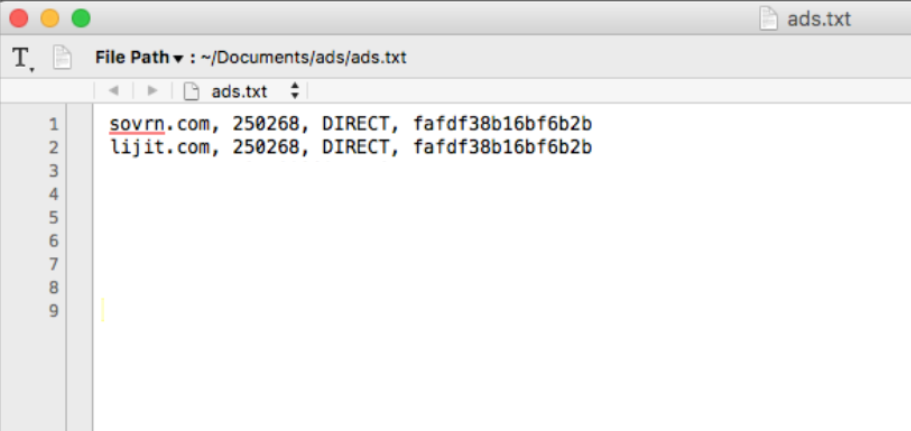
3) Connect to your website using FTP
- Open your FTP client and log in to your domain’s FTP using your web host credentials.
- Web host credentials are supplied by your hosting service (HostGator, GoDaddy, etc.) and listed as FTP accounts. You received these credentials via email when you signed up for your website.
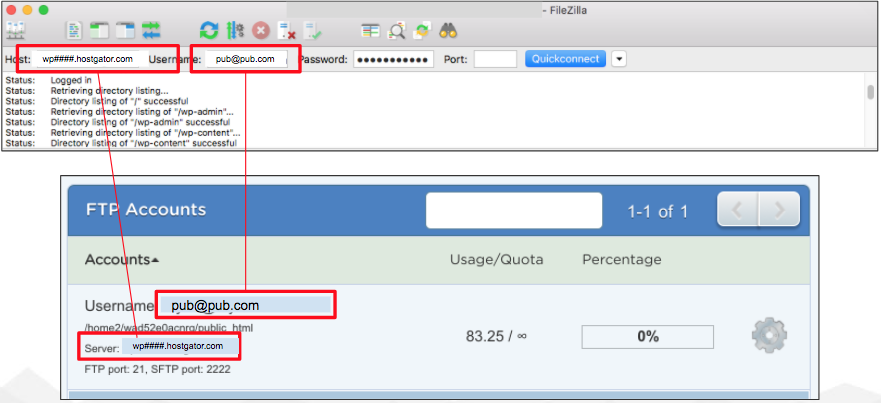
4)Locate your .txt file within the directory of your computer.
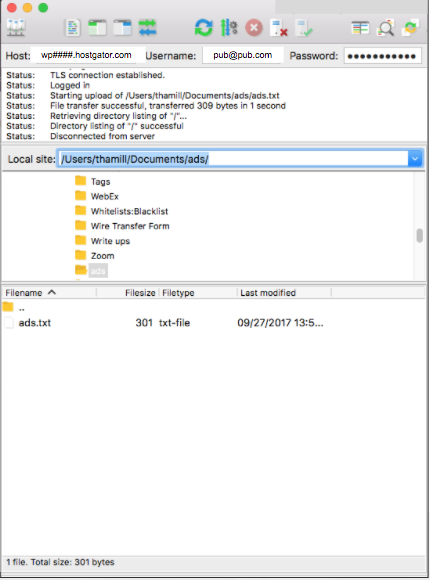
5) Select the .txt file, then drag it to your website’s home directory.
- This will create a path of the same file name after your domain. For example, our new path is called “https://domain.com/ads.txt”
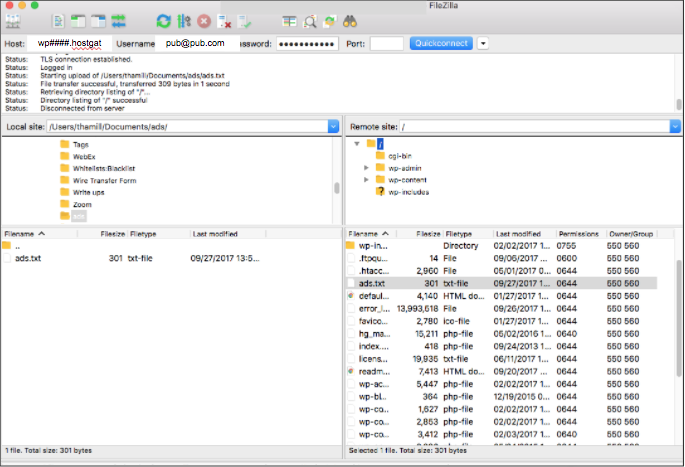
6) Open your internet browser of your choice and ensure ads.txt is displaying correctly by visiting the new domain path you just created; “https://domain.com/ads.txt”.
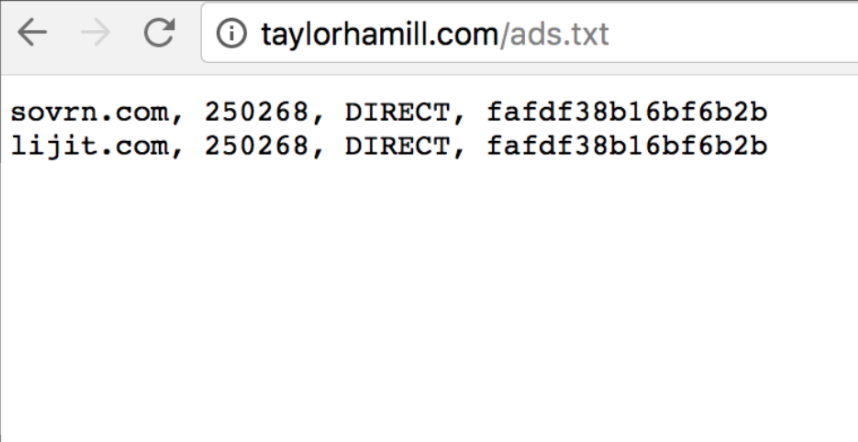
Proper Ads.txt Formatting Instructions
- Make sure to properly format your ads.txt information before adding it to your .txt file. Improper formatting will render the file ‘unreadable’ and invalidate it. Full IAB documentation can be found here.
- File Format and Syntax Requirements
- The core syntax is a comma or space separated format with three defined fields (outlined below) and one record/partner per line.
- No field should contain an embedded field separator (tabs, %, whitespace, etc).
- There are three required fields for each partner entry;
- Domain Name of the Advertiser (Required)
- The operational domain of your exchange partner
- Seller Account ID (Required)
- The identification number associated with your account for this partner
- Type of Relationship (Required)
- The kind of relationship that your partners have with the selling of your inventory. There are two options here.
- DIRECT indicates that the publisher has a direct business relationship with the SSP or exchange. There are no skips or jumps between the publisher and the SSP when selling inventory.
- RESELLER indicates that the publisher has authorized this entity to sell inventory on their behalf, through another party.
- The kind of relationship that your partners have with the selling of your inventory. There are two options here.
- Certification Authority ID (Optional)
- An ID that uniquely identifies the advertising system within a certification authority.
- Domain Name of the Advertiser (Required)
- Want to make sure that everything is properly formatted and ready to go? Check out AppNexus’ verification tool here.

Ads.txt Formatting FAQs:
- Will it work if a publisher puts ‘www.’ before each line?
- No! This is the most common way that publishers incorrectly implement Sovrn in their Ads.txt file. This leaves the publisher’s inventory vulnerable to digital advertising fraud.
- Why do ads.txt errors matter?
Sovrn Implementation Instructions
The very best way to receive the appropriate and most up to date Sovrn ads.txt information is to reach out to us directly. Your Sovrn representative will have exactly what you need but you are also welcome to email support@sovrn.com.
The file will include two DIRECT Sovrn entries (examples found in the ads.txt file creation instructions above) and a list of RESELLER’s.
It’s important to understand that Sovrn can resell your inventory in certain situations. Sovrn does this to increase the yield and revenue for its publishers. For example, there are some advertising campaigns with specific criteria, such as volume, viewability, or GEO. Sovrn will sometimes resell a publisher’s inventory in order to meet these specific advertiser criteria.
Organization Suggestions
As many publishers have come to realize when building out their ads.txt files, entries can start to pile up and things get unorganized quickly. Below are two main suggestions, within the proper formatting requirements, to help you keep your sanity.
- Break out all of your partner entries.
- Differentiate each partner entry so they are easier to find in the future. When partners make changes to their DIRECT and RESELLER entries it is helpful to know each partner’s location within your file.
- Space out and label each grouping.
- Put a space between each partner grouping to make distinctions clearer.
- Label each group with the name of the associated partner to better track which grouping belongs to whom.
Make sure to properly comment out your label of choice. This formatting requirement is a ‘#’ character.
Need an example? The image below shows a great ads.txt page that you can use for inspiration.
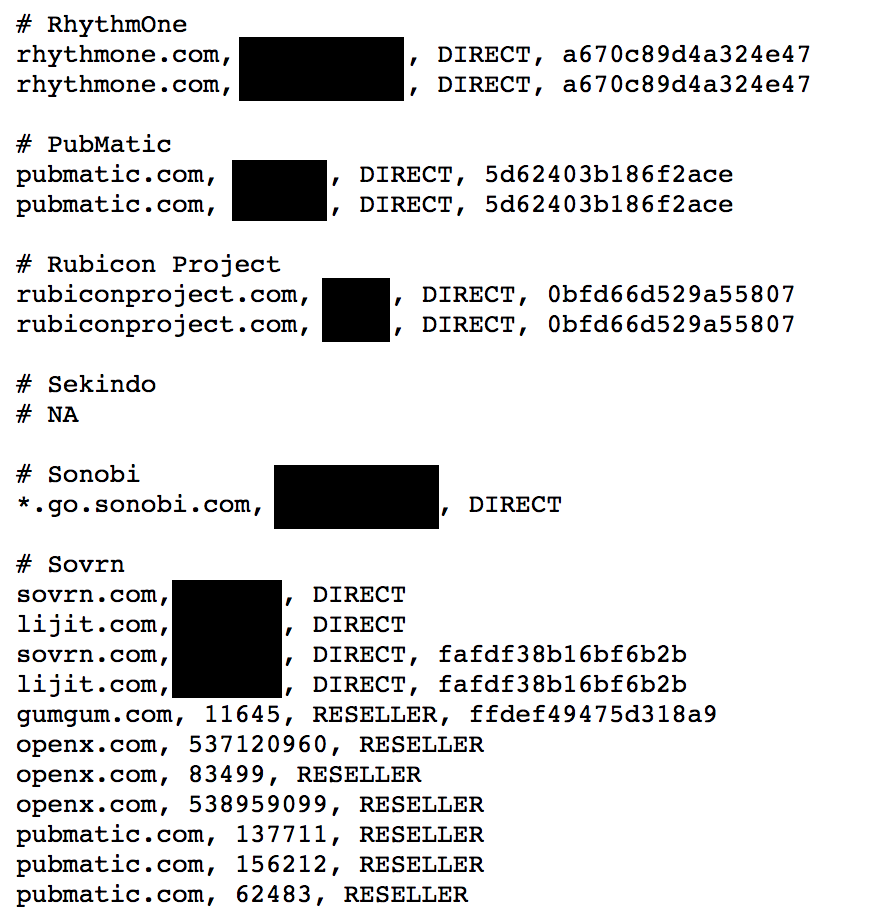
If you’re struggling to implement or update your ads.txt file, don’t hesitate to reach out to publisher support and let us know that you need help with your ads.txt. We’ll be able to walk you through the steps to make sure you’re using ads.txt correctly.

